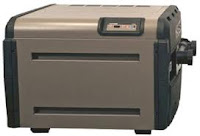I ran across an interesting problem earlier this week. I was working on a newer style Hayward UFD (Universal Forced Draft) heater.
It would try to light, then--after three attempts--it would fail and give an IF (Ignition Fail) error.
Many problems can cause this error:
- A bad flame sensor
- A bad ICB (Integrated Control Board)
- A bad HSI (Hot Surface Igniter)
- When there is first a call for heat, the ICB sends power to the HSI. If the current draw of the HSI is sufficiently out of range, the board will immediately trigger an IF error and the start up sequence will stop at that very point.
- If the HSI passes this initial self check, then the fan will come on and hopefully activate a vacuum switch thereby proving to the ICB that the fan is working. At this point, the HSI will start heating up. If you measure the current draw of the HSI using a clamp-on amp meter that is placed around one of its wires, you will initially see it draw about 3 amps, then slowly draw less and less current until it is drawing a pulsating 1-1.5 amps (the needle will actually pulsate up and down).
- The gas valve will then open for 4 seconds and the HSI should ignite the gas.
If the heater still fails to light it could be for several remaining reasons:
- Spider webs could be blocking the flow of gas to the burners. It is quite common for a spider to build a web that will clog up the gas orifice that supplies gas to the burners. These must be unscrewed from the manifold for cleaning. Poking a hole in the spider web and pushing it back into the manifold with a wire is a short term solution at best and at worst, will result in a roll out hazard later on.
- It is also possible that the heater fails to light because the gas valve isn't opening. Use a manometer on the manifold side of the gas valve to confirm that the gas valve opens and is supplying the proper amount of gas for combustion.
- It is also possible that you STILL have a bad igniter. Even though the igniter passed its self test and even though it draws approximately the correct amount of current as shown using the clamp-on amp meter, and even though it gets hot the the touch, it may still not be getting hot enough to ignite the gas. I found this to be true earlier this week. The HSI that was in the heater was simply not getting hot enough. I checked the resistance of this igniter against that of a new igniter. The existing (and bad) igniter had about 37 ohms of resistance. The new (and good) igniter read had about 15-16 ohms of resistance.
Some years ago with the advent of Low NOx (low nitrous oxide) heaters, many manufacturers switched from using pilot lights to ignite the burners to using direct ignition from a red hot glowing hot surface igniter. These work much like the electric heating element does on a stove or toaster. Just like a toaster can light your toast on fire, these hot surface igniters can light gas on fire.
Hayward's first shift away from a pilot light was to use direct spark ignition of the main burners. They then switched to using the same type of fragile hot surface igniters Pentair, StaRite, and Jandy still use.
These fragile igniters are made of Silicone Carbide. This material is very brittle. Replacement ones come packaged in foam rubber to prevent breakage during transport--and many of them still break during shipping. Installing them is a bit like playing the game that old game called Operation--one careless move and the igniter is broken.
Hayward chose to address this problem by switching to a more robust igniter made of silicone nitride. During their technical training seminars they show Power Point slides where these igniters have been hammered through a 2x4. This strenght is impressive for those of us familiar with the fragile-as-glass silicone carbide igniters. Nevertheless, despite their strength, they still fail. And, when they do fail, they can fail in ways that show no visible signs of failure. Such failure makes troubleshooting a little harder at times.

Comments